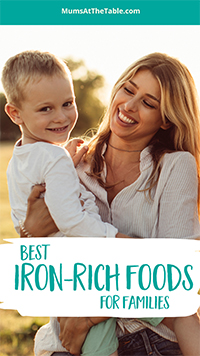Find ways to help your iron deficiency. Increase your iron—and energy—levels through food, and discover the best iron supplement recommendations.
Iron is an essential mineral, highly involved in all cellular functions in the body. It’s especially important for growth in babies and children. Low iron and anaemia affect over 1.5 billion people worldwide—it is common in preschool-aged children, women and the elderly.
Iron deficiency can cause chronic fatigue, low energy levels and a feeling of general discomfort. It can reduce redness in the skin, making you look pale or “washed out”. It can also cause symptoms that resemble a cold or flu (think aches and pains, coughs, headaches).
If you are struggling to keep your iron levels up or have a child who has been diagnosed with low iron, you’ve come to the right place.
Here, you’ll find ways to increase your iron levels through food, improve iron absorption through the gut, as well as the best iron supplement recommendations.
Causes of iron deficiency
The two most common causes of low iron levels are malabsorption in the gut (such as an inflammatory bowel disease) and blood loss (including heavy periods).
Women who have heavy periods can experience improvements by addressing underlying hormonal or metabolic issues. People who have irritable bowel syndrome, coeliac disease or food allergies are at high risk of developing iron deficiency anaemia and may need to regularly take iron supplements. The elderly can also struggle to maintain iron stores. This is often due to poor appetite, taking multiple medications that interfere with iron absorption (such as antacid medication) and low gastric sections.
The body is highly efficient at maintaining homeostasis (balance). It will only struggle when it’s not supported well enough to do its job. When iron levels in the body are low or iron needs are higher (such as during pregnancy), the body will increase the amount of iron absorbed and reduce the amount excreted from the body. However, iron-rich foods still need to be present in the diet and the gut needs to be working well to be able to absorb the iron.
How much iron do you need?
Below is a table of the recommended daily intake (RDI) of iron for age and gender.
0–6 months: 0.27 mg
7–12 months: 11 mg
1–3 years: 7 mg
4–8 years: 10 mg
9–13 years: 8 mg
14–18 years, male: 11 mg
14–18 years, female: 15 mg
19–50 years, male: 8 mg
19–50 years, female: 18 mg
Pregnant women require almost double the amount of iron (27 mg) to support their nutritional needs and that of their growing baby.
Popeye’s spinach: Iron-rich foods
Did you know that in the Australian diet, most of our iron comes from plant foods (non-heme iron) rather than meat (heme iron). This is true even for non-vegetarians.
Gone are the days when vegetarians were the only ones considered to have iron deficiency. Studies now show even those who have red meat as a regular part of their diet can have low iron. The main issue is absorption, as we already discussed.
Some common vegetable iron food sources include spinach, silverbeet, kale, parsley, bok choy and broccoli. We know that these foods are not usually on the “favourites list” and kids (sometimes adults) often grumble and groan at the mere mention. But there are ways of adding them into the diet while “hiding” them from view: You can make dips and hide iron-rich vegetables in them, cook soups with iron-rich veggies and then blend them, hide them in a delicious pie, or make pesto with kale and spread it on pizza.
Other plant-food sources of iron include iron-enriched breakfast cereals, beans, lentils, tofu, wholegrain bread, rolled oats, dried apricots, almonds and sunflower seeds.
Improving iron absorption
Some plant foods contain compounds that reduce the amount of iron our body absorbs. You can boost iron absorption from plant sources in several ways:
- Eat a wide variety of vegetarian iron-containing foods
- Combine them with vitamin C-rich foods, such as orange, mandarin, strawberries, kiwi fruit, capsicum, cabbage, broccoli and tomato
- Soak or sprout your nuts and seeds, legumes and whole grains
- Cook your plant foods to help increase the amount of iron available
- Avoid drinking tea and coffee with, or directly after, your iron-containing meal
- Avoid eating high-calcium foods, like dairy or calcium supplements, with or directly after your iron-containing meal
Citrus foods (even lemon juice over your veggies) and bitter greens (rocket, mustard greens) help promote gastric (stomach) secretions needed for absorbing iron. It will also provide you with high levels of vitamin C, which is important for increasing iron absorption, overall health and your immune system. And if you thought orange juice is the best dietary source of vitamin C, think again. Broccoli has almost double the amount of vitamin C than oranges.
Dietary iron is the preferred option over iron supplements as much as possible. This is because it’s more gentle on the gut and naturally better absorbed.
Iron supplements: Things to consider
Before starting iron supplementation, you must get a blood test from your GP or healthcare professional to determine your current iron levels. The blood test will detect your iron levels in the bloodstream (serum iron), the amount of stored iron (ferritin), how high your iron saturation is and how good your red blood cells are looking.
These are all very important measures as they directly affect each other. If your serum iron is at a good level, but your stored iron is low, it means your body is pulling from the stored iron, and you’re fast approaching iron deficiency or anaemia. When iron levels are low, the red blood cells also decrease and their size and shape change. This results in less oxygen being transported around the body, accounting for tiredness and feeling “puffed out” easily in the absence of physical exertion.
Iron supplements come in many forms, such as tablet capsules, liquid and in more urgent cases, injections or IV transfusions. Then there’s the type of iron such as ferrous sulfate, ferrous gluconate or iron bisglycinate.
Unfortunately, many prescription oral iron supplements, including iron tablets, can cause unpleasant side effects such as constipation, stomach discomfort, indigestion and nausea. Iron supplements found in health food stores are also not legally allowed to be used to treat iron deficiency. Iron injections are painful and IV infusions are tiresome and often have side effects that last from days to weeks. So what do you do?
Best iron supplements
If you want a gentle but high-strength iron, the best form is iron bisglycinate or ferrous bisglycinate chelate. Compared to iron salts, people have shown greater tolerability and lower incidence of adverse effects. This type of iron can be found in liquid form, tablets and capsules. If your healthcare provider has recommended you start iron supplementation, you can ask for products that contain this type of iron.
If you don’t currently have low iron but are prone to it, then you can take health food store dietary iron supplements in the form of bisglycinate. Some of the more popular brands include Fusion and Ethical Nutrients, which are gentler on the gut.
If you’re looking for a liquid iron, Floradix liquid iron is a good option. They even have one specifically for children. It also contains plants that are high in iron such as hibiscus and stinging nettle, and has some B group vitamins such as vitamin B1 and vitamin B2 that are vital for energy production. These options also do not have artificial flavours which is important for everyone, but especially for children.
It’s essential to note that iron and vitamin B12 are closely linked. If your vitamin B12 levels are low, it could be causing a low red blood count resulting in low iron.
Overcoming iron deficiency
We all need iron daily, preferably coming from food as the main source. Our diets should be well balanced, full of vibrant and rich colours. These foods have the best levels of vitamins, minerals and antioxidants.
If you or your child is experiencing symptoms that you think could be caused by iron deficiency, you must get properly tested. High iron levels or iron overload can cause all the same symptoms as low iron. High doses of iron can also cause inflammation and toxicity, and therefore you need to be well informed. Don’t simply rely on Dr Google.
Read: Does your child need multivitamins?
Any advice given is general in nature and is not intended as a substitute for medical advice and must not be relied upon as such. For any healthcare advice, always consult a healthcare practitioner.
This post includes affiliates and/or paid inclusions.

How helpful was this article?
Click on a star to rate it!
5 / 5. 1
Be the first to rate this post!
Adriana Wales
Related posts
Subscribe
Receive personalised articles from experts and wellness inspiration weekly!

